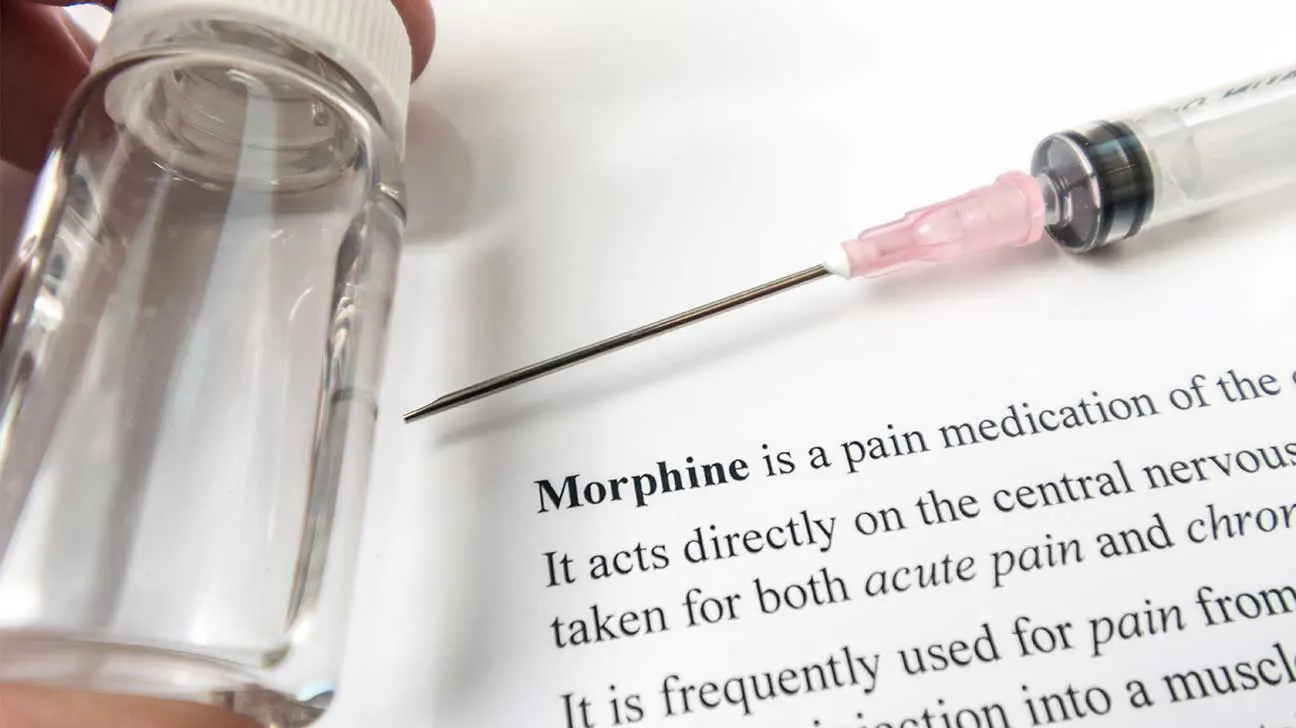
Millions of people seek pain relief from opioid analgesics like morphine every year.
Unfortunately, morphine is also a common drug of abuse. When abused over a long period of time, morphine can be highly addictive, which can cause a whole host of negative consequences.
Over time, morphine addiction may result in:
- physical health effects
- poor mental health
- risk for opioid overdose
- risk of illicit drug use (e.g. heroin use)
- chronic health problems
Achieving recovery from morphine addiction is possible. For many, this requires some form of substance abuse treatment, such as counseling or entering a drug rehab program.
What Is Morphine?
Morphine is a prescription opioid drug, like codeine, oxycodone, and hydrocodone. It’s used to treat moderate to severe pain, as well as chronic pain caused by medical conditions like cancer.
Morphine is marketed under the following brand names:
- Arymo ER
- Kadian
- Morphabond
- MS Contin
Although it is a prescription drug, it can also be administered in medical settings, or bought illicitly through a drug dealer or other illicit channel.
How Is Morphine Abused?
When taken as directed by a doctor, extended-release forms of morphine work by releasing their effects slowly over time.
Common forms of morphine abuse (e.g. injecting, or “shooting,” morphine) on the other hand can produce stronger, more rapid effects that can become addictive.
Common forms of morphine abuse include:
- snorting morphine
- plugging morphine
- injecting morphine
- mixing morphine with other drugs
Taking morphine in any way other than directed by a doctor can be very dangerous.
This can increase the risk of morphine overdose, as well as risk long-term health consequences such as nasal damage, collapsed veins, and abscesses.
Examples Of Morphine Abuse
Morphine abuse is any use of morphine that is not prescribed by a medical doctor.
What this can look like:
- taking higher doses of morphine than prescribed
- taking doses more frequently
- taking it for reasons other than prescribed
- taking it for longer than prescribed
- mixing it with other drugs to enhance effects
- taking a family member’s prescription
What Makes Morphine Addictive?
Prescription painkillers like morphine can be addictive largely due to their effects on the brain, which can cause a powerful rush of pleasure and result in a mental reliance.
When taken, morphine attaches to the body’s opioid receptors and increases the production of brain chemicals responsible for feelings of happiness and hormone regulation.
Over time and with repeated abuse, this can lead to physical dependence and a mental reliance on morphine, also known as drug addiction.
Signs And Symptoms Of A Morphine Addiction
Addiction isn’t intentional, nor is it a sign of personal weakness. This disease can affect anyone, regardless of age, gender, race, or ethnicity.
Signs of an opioid addiction aren’t always obvious. And people can often have a hard time recognizing when their drug use has become a larger problem.
The following are signs and symptoms of a morphine addiction:
- obsession with getting and using morphine
- strong cravings for morphine
- tolerance to the effects of morphine
- using more to feel the effects of the drug
- increasing dosage or frequency of use
- injecting, snorting, or plugging morphine
- continuing to abuse morphine despite negative consequences
- unable to stop taking morphine
- experiencing opioid withdrawal symptoms
Side Effects Of Morphine Abuse And Addiction
Morphine can produce rapid side effects, such as a sense of calm and reduced pain. When abused, morphine can also cause a number of physical, mental, and psychological side effects.
Side effects of morphine abuse may include:
- chest pain
- dizziness
- slowed breathing
- mental fogginess
- drowsiness
- constipation
- dry mouth
- headache
- mood changes
- fainting
- nausea and vomiting
- reduced blood pressure
- weakness
Serious side effects can also occur from morphine misuse. These include effects such as difficulty breathing, heart problems, seizures, and psychological disturbances (e.g. hallucinations).
Polysubstance Abuse: Common Drugs Mixed With Morphine
Opioids like morphine are sometimes mixed with other drugs. This can be done intentionally, or it might be the case that illicit forms of morphine are laced with other drugs.
Common drug combinations include:
- mixing cocaine and morphine
- mixing alcohol and morphine
- mixing other opioids with morphine (e.g. heroin, fentanyl)
What Are The Risks Of Long-Term Morphine Abuse?
Those who abuse morphine long-term are at risk for chronic health complications.
Long-term health risks from chronic morphine abuse can be serious, and may affect physical health, emotional health, as well as a person’s relationships and ability to work.
Risks associated with long-term morphine abuse include:
- chronic constipation
- insomnia
- weakened immune system
- erectile dysfunction
- menstrual problems
- nutritional deficiencies
- isolating from friends or family due to drug abuse
- decreased work performance or job loss
- developing morphine dependence and addiction
- morphine withdrawal symptoms
Another major concern of long-term morphine abuse is opioid overdose. Abusing morphine long-term can increase the risk of experiencing overdose, which can be fatal in severe cases.
Morphine Overdose Signs And Symptoms
Overdose can occur if you take too much morphine, or take morphine with other drugs, such as fentanyl, alcohol, benzodiazepines, or stimulants like cocaine.
Polysubstance abuse, or the abuse of multiple drugs at once, can increase the risk of overdose.
Overdose is considered a medical emergency. If you suspect you or someone you know has overdosed, call for emergency medical attention right away.
Signs of morphine overdose include:
- bluish fingernails and/or lips
- pale or clammy skin
- slow, stopped, or shallow breathing
- sleepiness
- limp muscles
- blurred vision
- pinpoint pupils (tiny pupil size)
- vomiting
- seizures
- gurgling noises
- unresponsiveness
Morphine overdose can be treated with the use of naloxone, or Narcan. This is an opioid overdose reversal drug that can save a person’s life when administered quickly.
How Long Does Morphine Stay In Your System?
Morphine can stay in the body for anywhere from a few days to several months. Morphine drug tests differ in their sensitivity and how long they can detect morphine use.
Morphine detection times:
- morphine detection in urine: up to three days
- morphine detection in hair: up to 90 days
- morphine detection in blood: from 12-24 hours
See more about how long morphine stays in your system.
Treatment Programs For Morphine Abuse And Addiction
Overcoming morphine abuse and addiction is possible. For most, this requires some form of addiction treatment or an opiate addiction rehabilitation (rehab) program.
Treatment begins with morphine detoxification. After this, entering an inpatient or residential rehab program for intensive morphine treatment is highly recommended.
Treatment centers for morphine addiction may offer:
- behavioral therapy
- group therapy
- medication-assisted treatment (e.g. methadone, buprenorphine treatment)
- mental health treatment (i.e. dual diagnosis)
- family counseling
- holistic therapies
- time away from external triggers
- relapse prevention planning
- specialty care (e.g. for pregnant patients)
- aftercare support
Higher levels of care, like inpatient treatment and residential rehab, are commonly recommended for people with a chronic or severe drug addiction.
Within a rehab center, you can gain access to ongoing, daily care. This includes medical and behavioral healthcare from a qualified team of treatment professionals.
Morphine Addiction FAQs
Find information about morphine addiction by reading answers to frequently asked questions.
What Type Of Drug Is Morphine?
Morphine is a natural opiate (or opioid) and central nervous system depressant. It is derived from the opium poppy plant, which is a plant grown in countries across the world.
What Is A Fatal Dose Of Morphine?
Morphine can be deadly in high doses, or if it’s taken in combination with other drugs. The lethal dose of morphine is about 200 milligrams (mg) or more for the average adult.
What Does Morphine Look Like?
Morphine comes in the form of extended-release capsules, tablets, and in liquid form. Due to its high potential for abuse and addiction, it is typically only prescribed for short-term use.
What Are The Street Names For Morphine?
Doses of morphine sold on the street may be referred to by a number of street names. Common street names for morphine include MS, morpho, dreamer, and white lady among others.
How Much Does Morphine Cost?
The cost of morphine can vary according to a wide range of factors, including the dosage, form, and where it’s bought. A single dose may cost anywhere from $0.52 to $30 per pill.
See more about how much morphine costs on the street.
Find Treatment For Morphine Abuse And Addiction Today
If you or someone you know struggles with morphine abuse, let us help you find a treatment program that meets your needs.
Call our helpline today to learn more about your addiction treatment options and begin your recovery journey.
Addiction Resource aims to provide only the most current, accurate information in regards to addiction and addiction treatment, which means we only reference the most credible sources available.
These include peer-reviewed journals, government entities and academic institutions, and leaders in addiction healthcare and advocacy. Learn more about how we safeguard our content by viewing our editorial policy.
- U.S. Drug Enforcement Administration (DEA) — Morphine https://www.dea.gov/factsheets/morphine
https://www.dea.gov/factsheets/morphine - U.S. National Institute on Drug Abuse — The Neurobiology of Drug Addiction https://www.drugabuse.gov/publications/teaching-addiction-science/neurobiology-drug-addiction
https://www.drugabuse.gov/publications/teaching-addiction-science/neurobiology-drug-addiction - U.S. National Library of Medicine: MedlinePlus — Morphine, Morphine overdose https://medlineplus.gov/ency/article/002502.htm
https://medlineplus.gov/ency/article/002502.htm - U.S. National Library of Medicine: NCBI Bookshelf — Morphine StatPearls https://www.ncbi.nlm.nih.gov/books/NBK526115/
https://www.ncbi.nlm.nih.gov/books/NBK526115/


